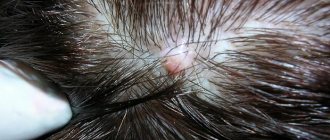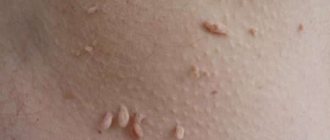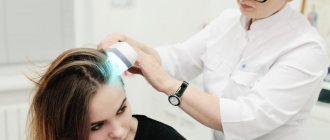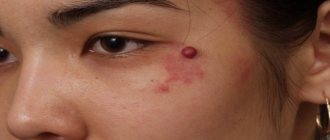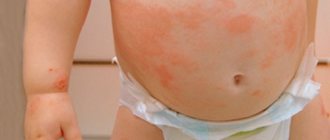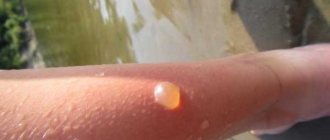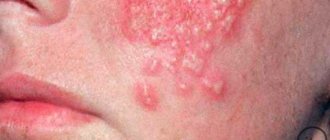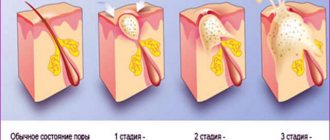What are red warts?
The red tumor that appears on the skin has no connection with a viral infection; it grows from the walls of blood vessels
Red warts are benign neoplasms that appear in places where there is a large accumulation of blood vessels. This feature explains their unusual color. They can have not only red, but also burgundy or purple tints. Most often, such warts are observed in girls and young women.
Sometimes warts appear as small spots on the body. They gradually increase in size. It is also possible that the dot will turn into a small spot, which over time becomes almost invisible due to the loss of its brightness.
Most often, red growths form on the human body during adolescence. Such neoplasms are also noticed by women during pregnancy.
Causes of red warts and treatment
Often warts and other growths on human skin are a sign of the HPV virus, but a red wart, as a rule, has nothing to do with it.
Some people are very afraid of any new growths on the body, including red warts. But in reality they may not pose any danger. And yet, to understand whether a red wart can cause harm to a person, you need to see a doctor, conduct an examination and undergo tests. Only on the basis of this data can one determine how dangerous a red wart can be.
Reasons for appearance
Red warts on certain parts of the body and on the face consist of vascular tissue that is filled with blood. If many capillaries were involved in the formation of a benign neoplasm, then it is quite large in size.
Medical experts put forward many theories that can explain the peculiarity of the occurrence of red warts in people of different ages. Most scientists associate the reasons for the appearance of such neoplasms with congenital anomalies. Others do not rule out the involvement of vascular tumors.
Red warts on the body of an adult can be caused by the following reasons:
- Mechanical damage. Most often these are bites, cuts and cracks in the skin. This category includes irritation and combing, which destroy the capillary network.
- Rapid weight gain or rapid weight loss. Such changes lead to stretching of the skin in certain places.
- Hormonal disorders. They can be caused by pregnancy, menopause and various diseases of internal systems and organs.
- Problems with the pancreas and liver.
- The growth of a malignant neoplasm inside the human body.
Red warts, also called hemangiomas, are found not only in adults, but also in children. A child develops such a growth for the following reasons:
- Reaction to hypoxia from vascular tissue.
- Genetic disorder in the development of vascular tissue.
In most children whose wart is caused by a second cause, it goes away closer to the age of five.
Doctors noticed that red warty growths appear in places where there is thin skin and blood vessels are located too close to its surface.
The main cause of warts
According to statistics, warts are considered a common skin disease that can occur in both adults and children. Depending on the variety, warts on the body may be pink, yellowish with a hard surface, or red. They belong to the class of benign neoplasms on the body.
The main cause of the appearance of such neoplasms is the human papillomavirus (HPV). There are about 60 types of this virus. The shape and color of the warts, as well as the speed of their spread, will depend on which virus has penetrated the body. A person does not always know that he is infected with HPV. The penetration of the virus may not manifest itself in any way at first, especially if the person’s immunity is strong. But such a person is a carrier of the disease, and if you come into contact with him, you can become infected.
The papilloma virus, penetrating the body, can be in a passive state and make itself felt only when the immune system is weakened. The appearance of at least one wart indicates the presence of a virus. It is difficult to diagnose HPV when it is in an inactive state, but it does not cause any particular harm during this period. Virus activity can occur due to:
- weakened immunity:
- presence of bad habits;
- hypothermia;
- lack of personal hygiene;
- constant stress;
- physical fatigue;
- lack of sleep;
- exacerbation of other chronic diseases;
- prolonged exposure to the sun;
- HIV infections;
- poor nutrition.
In view of these reasons for the activation of the virus, it is necessary to strengthen the immune system and treat diseases in a timely manner, preventing them from becoming chronic. Once infected with HIV, a person will need to take medications for the rest of their life.
Is there any harm to health?
Benign neoplasms that are red in color usually do not pose any threat to human life. If they do not cause him any discomfort, then he will not even pay attention to them. But some growths lead to health problems. Patients with red warts can expect the following troubles:
- The growths may become inflamed. As a result, bleeding ulcers and erosions form in their place.
- Large warts are easy to injure or completely tear off. This is fraught with severe bleeding.
- An infectious pathogen easily penetrates an injured wart.
It is strongly recommended that adults show red warts to doctors, even if they do not hurt or cause any discomfort. If a burning or itching occurs at the site of the growth, consultation with a dermatologist is urgently required, since such symptoms indicate the development of a pathological process. The doctor will examine the problem area and tell you exactly whether there is a need to remove the red tumor.
If a wart or condyloma of an unnatural color begins to increase in size over time, the doctor will refer the patient for a biopsy. After receiving the test result, he will be able to decide on treatment for the tumor. He will also give the doctor information about the cause of the growth on the body.
What are the reasons for the appearance and what does a red (blood) wart mean?
A red wart is a formation, the cause of which does not lie in infection with HPV. The red growths are benign in nature and are called hemangiomas.
Is it dangerous
Red warts are benign in nature and do not pose a health hazard to the wearer. They do not cause discomfort if they are not located in visible areas. Danger arises from accidental or special damage. The following problems will appear:
- inflammation of hemangioma with the formation of bleeding ulcers and erosions;
- damage to large warts is fraught with infection and inflammation with the release of pus;
- injury will result in bleeding.
If the red growths are large, it is recommended to undergo regular examinations with a dermatologist. The formation of a wart with a bloody spot in the middle indicates blockage of the capillaries, requiring special treatment.
If itching, peeling, or a sharp increase in size appear, consult a doctor; these are alarming symptoms indicating the development of a malignant process.
After examining the problem area and collecting tests, treatment is prescribed, with possible removal.
How to distinguish from other formations
Depending on the shape, the growths can be convex or flat, varying in the degree of deepening into the subcutaneous layers and tissue inclusions. The differences are influenced by the causes, nature and form. There are these types of warts:
- flat, resembling a mole in appearance, only red;
- cavernous - of different sizes, protruding above the skin. Depending on the shape, they are divided into: nodular, pineal and branched;
- mixed, formed from capillary cells, muscle and nervous tissue;
- combined warts are located above the surface with a depression in the tissue.
In childhood, it is impossible to classify the formation; it is initially represented on the body as a dot. As a person grows, it acquires shape and color.
Features of localization and diagnostics
The appearance of a hemangioma can be determined by the resulting mesh consisting of blood vessels. Then a spot is formed that differs from a nevus only in its red color, lumpy or nodular shape. Papilloma has a surface consisting of many small papillae.
Bloody warts often cover the upper part of the body.
On the head they occupy the face area, rarely the hair area. They affect the front and back of the neck, chest and back, the inside of the arms, fingers, and on the legs - the inside of the thighs. Rarely found on the foot, in areas of thickened skin layer. Damage to hemangiomas spreads to internal organs (liver, kidneys, intestines). Rarely, but can form on the surface of the brain.
Red growths localized on the nose, under the eyes, in intimate areas and butt have the ability to quickly grow and damage nearby areas of the skin.
During pregnancy, warts appear on the abdomen, chest, lower back, pubis and labia. Occurs for many reasons, including stretching of the skin associated with the growth and development of the fetus.
Effective removal methods
Do you need advice from an experienced doctor? Get a doctor's consultation online. Ask your question right now.
Ask a free question
Warts are treated with antiviral therapy, but the method is not effective against hemangiomas. If the red pigment spots do not interfere, are small in size and are not in a dangerous area subject to injury, treatment is not necessary.
Removal is required in cases of a cosmetic defect, a large area of formation, or in places of increased friction. The clinic will conduct diagnostics, study the causes and nature of the red growth.
The doctor decides which treatment will be effective in your case.
Taking pharmaceutical drugs
Treatment is based on taking hormonal and sclerosing drugs. Hormone therapy is effective, but not suitable for everyone. Prescribed by a doctor, medication is taken under the supervision of a specialist.
Treatment with the sclerosing method involves a subcutaneous injection of ethyl alcohol in the area with the red wart.
Its injection effect promotes the formation of scar tissue, which constricts the blood vessels, causing the gradual destruction of the element.
Surgical removal
You can remove warts using several methods, the effectiveness of which is justified.
| Method | Description |
| Laser therapy | Removal occurs with a laser, which excises the red formation painlessly and quickly. The laser removes warts in hard-to-reach areas, on the face and intimate areas. The procedure is suitable for children. The result is clear skin without scars or scars. |
| Cryodestruction | Getting rid of red growth by freezing cells. During the procedure, the area is treated with liquid nitrogen. A repeat procedure may be required for complete removal. |
| Diathermoelectrocoagulation | During the manipulations, a high-frequency current apparatus is used to excise the red formation and seal the vessels. A positive aspect of the method is the absence of bleeding. Applicable only in cases with external growths. |
| Radio wave | Excision of the wart occurs using a radio knife. Does not leave scars or scars. The operation is quick and painless. |
| Surgical | An effective way to get rid of unwanted growth entirely and in one go. Allows you to remove subcutaneous and large elements, minimal likelihood of relapse. Leaves a slight scar. |
Removal using traditional methods
It is not recommended to carry out removal using alternative medicine methods. With home treatment, there is a high risk of complications; a network of blood vessels is involved in the formation of the red formation.
Treatment of red warts
If you suspect a red wart, you must undergo an examination by a dermatologist and undergo tests
Treatment of red growths depends on the number of growths, their volume, color and location. In most cases, patients do not require special therapy. This need usually arises when a wart causes discomfort to a person. The indication is also a high probability of injury to the neoplasm.
To prevent the growths from growing and to completely deal with the red dots, it is enough to seek help from a dermatologist. He will examine the problem area and choose the most optimal treatment method for the patient.
Medication therapy
Several types of drug therapy have been developed to combat red warts. All of them are based on the use of various drugs that are highly effective against such tumors.
Drug therapy against red warts can be of two types:
- Hormonal. Gives good results if you select the right medicine. It is worth noting that hormonal drugs are not suitable for all patients, so this treatment cannot be called universal.
- Sclerosing. Its essence is to inject ethyl alcohol under the skin of the patient, directly into the area where the red wart is located. This composition leads to the formation of scar tissue, which has a compressive effect on the blood vessels. As a result, the death of neoplasm cells is observed.
Both methods of drug treatment are carried out exclusively under the full supervision of the attending physician. This takes into account possible contraindications to the chosen therapy that the patient may have.
Surgical assistance
Surgical treatment is the fastest and most effective method for removing red warts on the body. There are several main varieties that are actively used today in the fight against these tumors.
| Treatment method | Description of the method | Contraindications | approximate cost |
| Cryodestruction | The essence of the procedure is to expose the wart to extremely low temperatures, causing its tissue to quickly die. | This method is not suitable for hypersensitivity to nitrogen, acute respiratory viral infections, hypertension, during pregnancy and breastfeeding. | 300-1300 rubles. |
| Electrocoagulation | Removal is carried out by cauterizing the benign growth and sealing the blood vessels. The method is suitable for the treatment of external warts. | Treatment is contraindicated in the presence of malignant tumors and inflammatory processes. Electrocoagulation should not be used to treat growths that are located too close to blood vessels. | 200-1000 rubles. |
| Laser coagulation | The procedure is considered the most gentle and fastest method of removing red warts on different parts of the body and face. It is suitable even for children. | Laser therapy is prohibited for acute respiratory viral infections, acute chronic diseases, malignant tumors and during pregnancy. | 500-1900 rubles. |
| Surgical excision | It is actively used in the treatment of subcutaneous red warts that are large in size. | Treatment is not suitable for patients who have experienced an exacerbation of herpes or another infectious disease. | 800-1600 rubles. |
Causes of appearance on various parts of the body
Condylomas can appear on any part of the human body. They are formed due to the proliferation of epithelial cells. The number of warts depends on the state of the immune system.
Either a single or multiple formation may occur, covering a large area of the body. The main reason why warts appear is the papillomavirus, but depending on the location, there are other reasons that provoke their formation.
Warts should not be exposed to ultraviolet radiation , as it promotes their progressive development.
Let's find out further where warts come from and how to get rid of them.
On hands
Where do warts on hands come from? Condylomas on the hands are common. Most often they appear during adolescence.
Initial infection occurs in children from 3 to 5 years old , but at this age the body actively resists the virus. But when the child enters the teenage phase, the virus is activated, resulting in the appearance of a wart in the child.
So, why do warts appear and how to get rid of them?
- This is facilitated by a lack of vitamins during the period of active development, mental and nervous stress at school, and colds.
- The reasons for the formation of warts on the hands can provoke dry skin, since it is most susceptible to minor damage.
- Hypothermia of the hands in winter also leads to the formation of warts, due to a decrease in blood circulation in them.
- If there are injuries on the hands, associated with a lack of hygiene, this also leads to an unpleasant consequence.
- Infection can occur during a manicure procedure, when using poorly disinfected tools.
You can get rid of warts using folk remedies, including removal with a thread.
On the face
Let's figure out how warts appear on the facial part of the body.
Most often, warts on the face occur with age or in adolescents during puberty .
What causes warts on the face? The appearance of warts in women can be caused by hormonal imbalances due to pregnancy or taking medications, and in men - by cuts during shaving .
Oily skin, prone to inflammation and acne formation, is also a possible cause of the formation of warts.
The appearance of warts on the face may be due to diabetes.
If a wart appears on the face, the following pharmaceutical preparations will be effective and not dangerous:
- pills and injections;
- special ointments for warts, such as Viferon;
- iodine;
- Castor oil.
Next, let's talk about why warts grow on the feet.
On foot
In the early stages, condylomas on the feet are often confused with calluses.
They cause a lot of inconvenience to a person - the inability to wear open shoes, pain and discomfort when walking, and difficulties with playing sports.
The reasons why warts appear on the feet are excessive sweating and neglect of hygiene .
Visiting public swimming pools and saunas can lead to infection. High humidity and softened skin of the feet allow the virus to quickly enter the body. Sharing towels and shoes is not recommended in such places.
Constant rubbing of the feet and the formation of calluses are favorable conditions for the formation of warts. And when visiting a pedicurist, you need to make sure that the instruments are sterile.
The methods of our grandmothers will help you remove a wart on your leg at home. Namely:
- celandine;
- garlic;
- potato;
- vinegar.
In traditional medicine you can use:
- freezing with nitrogen at home (Wartner Cryo, Cryopharm);
- cauterization of growths with such means as Supercelandine, lapis pencil and hydrogen peroxide;
- special patches (Salipod).
Why do they appear in intimate places?
If warts occur in intimate places, you should consult a doctor to rule out the presence of sexually transmitted diseases.
Pregnancy and disruption of the vaginal microflora can lead to their appearance.
Promiscuous sexual activity, unprotected and oral sex also lead to the appearance of warts in the intimate area.
The main symptoms include burning, discomfort, pain during sexual intercourse.
For women, the formation of condylomas in the intimate area is more dangerous , since they affect not only the external genitalia, but also the vagina or cervix. This can lead to problems with conception or infection of the fetus.
For the treatment of warts on the genitals, clinical methods are best suited, namely:
- laser removal;
- cryodestruction;
- radio wave method;
- surgical excision.
The best methods of removal today are laser and cryodestruction, although sometimes there are consequences after nitrogen. If you want to know which method is better, then read this material.
We also recommend finding out whether it is possible to remove a wart during pregnancy.
What it is
The formation of red color on the skin is not caused by a viral infection, it grows from the walls of blood vessels.
This explains its rich color, sometimes with a purple tint.
- Typically, such neoplasms can be found in a child at birth, or they appear in the first months of his life. Girls are most susceptible to them.
Photo: hemangioma on a child’s face
- At first, such a wart may look like a small dot. Subsequently, it grows in proportion to the age of the child, and may bulge on the surface of the skin or remain in the form of a spot. Sharp dynamics can be observed during puberty or with the onset of pregnancy, which is due to hormonal changes in the body.
In fact, such neoplasms are not warts, they are hemangiomas.
The principles of their treatment are also completely different. Hemangiomas are benign formations.
But, in any case, monitoring their growth and consulting a doctor are necessary.
Reasons for appearance
Red warts on the body have causes that are not fully understood by medicine.
- It is assumed that they may appear due to disturbances in small blood vessels, which provoke their interweaving.
- The role of a certain group of proteins that are produced by the placenta during a woman’s pregnancy is also not denied.
Other reasons are also called:
- damage to the skin - such formations often appear in areas that were previously injured (irritation, inflammation, scratching, cuts, etc.);
- stretching of the skin (in the abdominal area during pregnancy, with sudden weight loss or, conversely, rapid increase in size) - usually red warts appear in those places where the skin has been stretched (on the stomach, on the leg in the thigh area, etc.) ;
- diseases of the liver or pancreas can also cause the appearance of red dots, especially in the upper part of the body;
- bleeding disorders - can cause red or bluish spots to appear, but they usually resolve on their own within a week or two;
- manifestation of cancer - sometimes the presence of a malignant tumor in the body can be accompanied by multiple rashes on the skin in the form of red dots.
What affects a specific type of such a neoplasm is also not completely clear.
It is only noticed that red formations appear on the body in places where the skin is thinnest, where the vessels are closer to the surface.
Therefore, they can usually be found on the face, inner surface of the arms, neck, chest, and abdomen.
All iLive content is reviewed by medical experts to ensure it is as accurate and factual as possible.
We have strict sourcing guidelines and only link to reputable sites, academic research institutions and, where possible, proven medical studies. Please note that the numbers in parentheses ([1], [2], etc.) are clickable links to such studies.
If you believe that any of our content is inaccurate, out of date, or otherwise questionable, please select it and press Ctrl + Enter.
Unlike other warts, the typical red wart is not associated with exposure to the human papillomavirus. However, the etiology of the neoplasm may be different. In addition, such a neoplasm often has an unaesthetic appearance and can cause discomfort. Is it difficult to get rid of such a wart, and how to do it correctly so as not to cause harm?
[1], [2], [3]
Red wart on the back
Moles can exist on the body immediately after a person is born, or they can appear as the body grows. Red moles on the body - angiomas - are benign formations formed due to improper functioning of the blood vessels or lymphatic system. Red moles can be located in different parts of the body, as well as at any depth, depending on the location of the damaged vessel. Such formations have one common feature: when pressed, the mole turns pale, and then again acquires a bright color.
Photo of red moles
Causes of moles
If an angioma is present on the child’s body from birth, the likely cause of its appearance may be infectious diseases suffered by the mother during the period of intrauterine development of the fetus - exacerbation of chronic infections, pyelonephritis, viral acute respiratory viral infections. Usually small moles (up to 1 cm) go away on their own in the first 7 years of a child’s life.
In adults, angiomas are detected less frequently, and in this case there is a hormonal imbalance in the body, diseases of the stomach and intestines, liver, and pancreas. The appearance of small red dots on the body can be caused by prolonged sun exposure and excessive use of solariums. Sometimes angiomas on the body indicate diseases of the circulatory system.
Further growth and increase in the number of moles may occur due to improper functioning of skin pigments. Proven. that people with fair skin and hair are more prone to the appearance of moles.
Types of red moles
Angiomas differ in location relative to the depth of the skin and the type of vessel that caused its appearance (capillary, venous, arterial). Based on external features and size, we can distinguish:
- The most common type of red mole is capillary hemangioma. Represents a fracture or expansion of a capillary vessel; the appearance of the mole is a blue-purple or bright red spot, location is any part of the body or face. In children, capillary hemangiomas are localized in the groin, ankles, arms, neck, chest, and face.
- Cavernous (cavernous) hemangioma combines several blood vessels connecting to form large cavities. It is located above the skin and is covered on top with a thin layer of epidermis. Quite often it is located on the face, which disfigures a person. It can be localized in the spleen, liver, uterus and, having an impressive size, interfere with the work of these organs.
- Branched hemangioma looks like a pulsating, swollen formation filled with blood. Unites several simple moles connected to each other. If you press on such an angioma with your hand, there is an outflow of blood, after which it fills again.
If the angioma appears as a round red dot, it is called punctate. If small capillaries extend to the sides of the mole or it does not have clear contours, the angioma is usually called stellate or arachnid. Based on the composition of the tissues that form angioma, branched, flat, nodular and knob-shaped moles are distinguished.
Diagnosis of red moles
Usually, red moles do not cause the owner any problems other than aesthetic ones. Even large moles do not affect the rise in temperature or deterioration in health.
After consultation with a dermatologist or surgeon, an external examination of the body, and questioning of the patient about the manifestations and symptoms of the formation, an additional appointment with a gastroenterologist, neurologist, or endocrinologist may be scheduled. This depends on the reasons that caused the appearance of a mole in an adult, as well as the doctor’s possible suspicions about the localization of other formations, for example, on internal organs.
If the angioma is large or if it is suspected of malignancy, a specialist may give a referral for a biopsy.
After consultation with a pediatric surgeon, a decision is usually made to leave the mole on the body until the age of 5-7 years, but only if it is not of impressive size or is not located in places subject to friction by clothing.
Consequences of red moles
In some cases, especially when exposed to unfavorable factors: ultraviolet rays, damage to moles by clothing, jewelry or shoes, angiomas can degenerate into malignant tumors. The main problem and danger of red moles is their ability to degenerate into skin cancer.
In addition, if removed independently or accidentally exposed, red moles can cause severe bleeding. and then grow in size.
After a mole is removed or disappears on its own, a white scar may remain on the skin. Angiomas in children located close to the eye and nose can, if they increase in size, cause disturbances in the sense of smell and vision.
Treatment of red moles on the skin
In most cases, small red moles do not require treatment or removal, especially if they are not located on the face. If the mole is not subject to friction by clothing and does not increase in size, it is also better not to remove it. A change in color or size is a reason to urgently consult a doctor.
Treatment methods for angiomas depend on the location and type of tumor. Simple capillary hemangiomas can be treated or removed using the following methods:
- X-ray radiation. The specialist prescribes a course of sessions of this technique, after which the red mole becomes lighter, its size decreases, and over time it may disappear altogether. We must remember that X-rays can be hazardous to health, so modern medicine does not recommend using this method.
- Surgical excision. This method of mole removal can be performed at an appointment with a surgeon in a clinic and is more suitable for small moles located on the body. After surgical excision, scars and scars may remain on the skin.
- Cauterization of red moles with carbon dioxide. Since the mole is located in the deep layers of the skin, this method may be ineffective and lead to further growth of the mole due to the fact that its base remains intact. It is suitable only for small formations located above the surface of the skin.
- Larger capillary hemangiomas can be successfully treated with chemical sclerotherapy. To do this, special preparations are injected into the formation and the skin around it, blocking the vessels of the mole and separating it from the general blood flow. As a result, the mole gradually decreases in size and disappears.
- The cryodestruction method involves freezing the mole with liquid nitrogen. Suitable only for those moles that are located above the surface of the skin and do not affect its deeper layers. As a result, the angioma vessels become fragile and then collapse.
- Cauterization of moles using the coagulation method. This method of removing angiomas is quite effective and safe, suitable for large capillary formations, and also does not leave scars. There are several methods of coagulation - radio wave, electrocoagulation, as well as modern techniques - light and infrared. During the procedure, a layer of anesthetic is applied to the skin around the mole and to the angioma itself. To remove large formations, local injection anesthesia is first performed.
Cavernous or branched hemangiomas often require surgical treatment, and in several stages. Small formations can be cured using radium application, as well as by ligating the hemangioma vessels at the point of their connection with healthy ones. At the same time, excision of large trunks of the mole is performed.
Perhaps the most popular method of removing angiomas is the use of carbon dioxide or vascular laser. In this case, excision of the mole is carried out layer by layer, therefore it allows you to completely get rid of the formation of any depth. Laser beams leave minimal scars after the skin has completely healed. Anesthesia is first performed with an injection or anesthetic gel. Since the laser angioma removal procedure lasts only a few seconds, it is well tolerated by patients. After a day, the skin at the site of the mole becomes covered with a crust, which disappears within 1-3 weeks.
After removing the angiomas, the specialist examines the resulting material for the presence of malignant cells. For 1-2 months, it is not recommended to expose the area of the angioma to insolation, and also not to visit the solarium and sauna.
Treatment of red dots on the body using traditional methods
Traditional medicine offers several methods for lightening or cauterizing red moles.
These methods can only be used if the size of the mole is minimal and its growth is not observed. It is strictly forbidden to independently treat large formations, as well as those that affect the deep layers of the skin.
- Apply a small amount of castor oil to moles at night. After a month, the formations will begin to decrease.
- You can apply an antiviral ointment, such as acyclovir, to the angiomas daily.
- To lighten moles, you need to apply a gruel of grated black radish to the mole 2-3 times a day.
- Wash the dandelion root, chop it and apply it to the angioma for 2-3 hours in the form of a compress every day.
- You can lubricate the mole with onion juice. As a result, the formation will dry out and disappear.
- Bee honey is good for getting rid of moles. It is enough to lubricate red moles with it every day, and after a couple of weeks they will begin to shrink.
- Fresh milkweed grass must be crushed, and then apply this mass to the mole. Tie and leave for a couple of hours. Carry out this session once a day for a week.
- Wash a small potato, cut it into 2 parts and wipe the red moles with the juice.
- Combine finely grated apple and honey in equal parts, lubricate the mole and leave under a cotton bandage and cellophane overnight. Repeat 3-4 times.
- Mix 50 ml. apple cider vinegar and 3 drops of lemon essential oil, then lubricate the mole 2 times a day.
- Crush 2 cloves of garlic under a press, add 2 teaspoons of apple cider vinegar and flour until a thick dough forms. Cover the area around the mole with a band-aid and apply this dough to it for 5-6 hours.
- You can significantly lighten a mole if you alternately lubricate it with lemon and garlic juice. Repeat 2-3 times a day.
- Pineapple juice, when applied daily as a lotion to a mole, can make it pale and invisible.
- Mix honey, flaxseed and castor oil in equal proportions. Apply a compress of this mixture to the mole and hold for at least 30 minutes.
Since traditional medicine is skeptical about such methods, it is recommended to first consult with a specialist, and, if the red mole is not dangerous, try traditional medicine.
Health to you! With UV. team of the site VashDermatolog.ru
News that helps!
https://vashdermatolog.ru
Causes of a red wart
Experts cannot pinpoint the exact cause of the formation of a red wart: presumably, the etiological factor may be a congenital anomaly, or acquired problems with blood vessels and the circulatory system.
The red color of the growth is due to its origin: it has a vascular structure and is filled with blood. Most often, this structure is represented by tiny capillaries, and the more such vessels, the larger the size of the wart.
Red warts often appear in adulthood, and the following factors contribute to their appearance:
- traumatic damage to the skin (scratches, cracks, scratches, punctures);
- changes in the skin caused by sudden weight loss or, conversely, weight gain (a wart may appear in a fold or in an area of stretched skin);
- hormonal changes (meaning sudden changes - for example, in pregnant women, during menopause, when taking hormonal contraceptives, with hyperthyroidism, etc.);
- liver diseases, chronic pancreatitis;
- tumor processes.
In early childhood, the appearance of red warts is often associated with impaired development of the vascular network, or with intrauterine hypoxia.
[4], [5]
Forms
A common red wart can be located on almost any part of the body. It looks like a dense red nodule and may also have a yellowish or pinkish tint.
Smaller formations sometimes appear around the wart. The skin over the usual growth is dry, rough and rough.
A flat red wart is most often located in the face or on the hands: it looks like a small elevation above the skin. Sometimes this formation has the appearance of a callus, with a compacted stratum corneum. If it is located near the nail, then it is called a periungual growth. Often such a growth is formed due to injuries and regular nail biting.
Red warts on the scrotum and genitals often have a pointed or flat shape. They appear in sexually active adults. There are quite a lot of such neoplasms; they can be periodically injured, disrupting the normal course of sexual life.
[8]
How to distinguish from other formations
Depending on the shape, the growths can be convex or flat, varying in the degree of deepening into the subcutaneous layers and tissue inclusions. The differences are influenced by the causes, nature and form. There are these types of warts:
- flat, resembling a mole in appearance, only red in color,
- cavernous - of different sizes, protruding above the skin. Depending on the shape, they are divided into: nodular, pineal and branched,
- mixed, formed from capillary cells, muscle and nervous tissue,
- combined warts are located above the surface with a depression in the tissue.
In childhood, it is impossible to classify the formation; it is initially represented on the body as a dot. As a person grows, it acquires shape and color.
Complications and consequences
A red wart rarely causes complications if you do not touch it, do not injure it, and do not try to get rid of the growth yourself. Otherwise, the consequences may be as follows:
- the wart may increase in size and spread in the form of multiple rashes;
- infection, suppuration, and development of an inflammatory reaction may occur;
- When damaged, a red wart can bleed heavily;
- Rarely, a wart can become malignant.
To avoid troubles, the tumor should be removed by a qualified specialist. To do this, there are a lot of various medicinal, hardware and surgical methods. The doctor will select the most optimal method after assessing the existing contraindications and the general health of the patient.
[9], [10], [11], [12], [13], [14], [15], [16], [17]
The main types of red moles
Red moles differ from each other depending on the cause of formation and location in the skin. Typically, the neoplasm consists of small capillaries, is flat or convex, and has a red or pink tint. If small vessels visible to the naked eye diverge from the mole in different directions, then it is called arachnid or stellate, otherwise – dotted. If there are several neoplasms and they are located nearby, then this is a cavernous or cavernous angioma.
An excessively large red mole is called a hemangioma. Its occurrence is due to the rapid growth of ordinary angioma, and, as a rule, treatment consists of surgery.
If red moles appear on the body, it is usually characterized by the following symptoms:
- occurrence on any area of the skin;
- red or pink tint of the neoplasm;
- There are no complaints about deterioration of health and fever.
Situations where neoplasms hurt and affect general health are atypical and require immediate attention to a medical specialist.
Most often, a red mole does not exceed 1-2 millimeters in diameter and rarely continues to grow. There are also unique cases when these types of growths itch or are accompanied by pain. The total number of red moles throughout the body rarely exceeds 5-10 pieces.
This is interesting: How to distinguish a plantar wart from a callus
Diagnosis of a red wart
Identifying typical red warts is usually not difficult for a doctor: the diagnosis is made immediately after examining and feeling the tumor. During the examination, the doctor takes into account the characteristic color, discoloration when pressed, localization and other signs.
If difficulties arise with diagnosis, as well as in case of ineffective treatment of a red wart, it is advisable to conduct a histological examination. Histology helps to detect such nuances as epidermal acanthosis and papillomatosis, hyper and parakeratosis with long papillary elements. The capillaries of the dermis are well defined and are often thrombosed, with the presence of mononuclear cells around the circumference. If the red wart is related to the human papillomavirus, then keratinocytes will be found with an eccentric localization of the pyknotic nucleus with koilocytes. The infected structure may have small eosinophilic granules, and with condylomas, slight acanthosis and parakeratosis are found. Sometimes koilocytes are detected in the latter against the background of an increased vascular pattern.
General tests are not necessary to diagnose a red wart. If the presence of human papillomavirus is suspected, a scraping is made from the neoplasm and the material is sent for PCR diagnostics. This type of test helps determine the type of HPV.
Instrumental diagnostics are usually limited to biomicroscopy of the skin, examination with a magnifying glass or Wood's lamp, and biopsy of the tumor.
[18]
Differential diagnosis
Differential diagnosis of a red wart is carried out with lichen planus, in which a waxy sheen and a reddish-purple color of the growth are detected. Warty cutaneous tuberculosis also requires differentiation: with this pathology, the growths contain an inflammatory infiltrate and a violet-red rim along the periphery.
In difficult cases, a biopsy is used for differentiation - a microscopic examination of tissue taken from the wart. The procedure is carried out in a clinic using special diagnostic equipment.
[19], [20], [21], [22], [23]
Treatment of a red wart
For most people, red warts do not require any treatment or rush to get rid of them. Doctor's help is necessary only in certain situations:
- if the wart suddenly becomes painful;
- if there is itching or swelling around the tumor;
- if the red wart begins to bleed;
- if the growth continues to increase in size;
- when the color of the wart changes from red to darker or even black.
For the treatment of red warts, people usually consult a dermatologist. You should not immediately go to beauty salons or other institutions that promise to remove a red wart without a trace: first you need to undergo diagnostics and make sure that it is really a warty formation and not another dangerous pathology.
Most often, red warts are removed surgically. But there is also drug treatment, which in some cases can be effective. This treatment varies:
- with the use of hormonal drugs;
- with the use of local sclerosing agents that cause necrosis of growth cells.
Both the first and second methods are used only by a medical specialist, taking into account all possible risks and contraindications.
Some pharmaceutical drugs can also help with ordinary red warts:
- patches based on keratolytics (with lactic or salicylic acid);
- applicators with a gel base containing 40% trichloroacetic acid.
Among the most famous and popular patches are “Salipod”, “Ultra Profi House”, “Suda Epitact”, etc.
Medicines that a doctor may prescribe
If the viral origin of a red wart is proven, the doctor will definitely prescribe antiviral treatment. Local use of appropriate medications prevents the spread of infection to healthy areas in cases where the red wart is impossible or difficult to remove. For this purpose, use oxolinic ointment, Viferon or Tebrofen ointments. The dosage and duration of therapy is determined by the doctor.
Sometimes they practice rubbing 5% fluorouracil ointment, 0.5% colhamine ointment, 20% interferon, trichloroacetic acid.
Magnesium oxide can be taken orally in the amount of 0.2 g three times a day for 14-20 days. Local use of drugs containing salicylic and benzoic acid and tretinoin is indicated. The frequency of use of such ointments is twice a day, for several weeks.
Treatment methods for warts on the body
When warts appear on the body, their treatment will not depend on the cause. So, if they are small and there are few of them, then usually one course of therapy with external agents is quite enough. If this still does not help, you can always approach the problem more seriously by starting to take oral medications to suppress the activity of the virus and strengthen the immune system. If necessary, those who want to speed up recovery can combine these two methods.
Folk remedies against warts on the body
There are many options here, from baths to compresses. You can simply wipe the growths with folk remedies or leave them on the surface for a certain time, depending on the recipe. On average, treatment lasts 1-3 weeks, the larger the size of the formations, the longer the recovery takes.
There are the following types of products that can be used to remove warts on the body:
- Juices . An extract from fresh aloe, celandine, and lemon helps best. They need to be squeezed out only before use, otherwise the product may lose some of its beneficial properties. Next, they need to soak a cotton pad and wipe the formation. It is quite enough to carry out such procedures for removing warts on the body 3 times a day. This should not be done if the integrity of the skin is damaged, otherwise it may burn.
- Oils . Here we can recommend making compresses from olive, burdock, castor, and coconut oil. To do this, soak a cotton pad in it and apply it to the growth, leaving it there for 15-20 minutes. Such procedures must be performed 2-3 times a day until the formation is eliminated. To enhance the effect, it is recommended to heat the oil before use.
- Decoctions . To prepare them, you can use, for example, wormwood, but it must be dried. It (2 tablespoons) must be poured with boiling water (200 ml) and cooked over low heat for about 15 minutes. Next, the mixture should be left covered for half an hour to allow it to brew and cool. Then you should drain the liquid, moisten a piece of gauze in it and treat the formation. To remove warts on the body, such actions should be performed 4 times a day for 1-3 weeks, depending on the reaction of the growth. Nettle and plantain leaves are often used as an analogue of wormwood, but the latter are taken fresh.
- Infusions . Dandelions, which (3 tsp) need to be poured with boiling water (250 ml) and left under the lid for about 30 minutes, are excellent for warts on the body. Next, the composition must be filtered and cooled. They need to wipe the formations 5 times a day with a cotton swab. In addition to this, you can take an infusion of lemon balm (1 tsp) and linden (2 tsp), poured with boiling water (300 ml). This composition, after filtration, to remove warts on the body, you need to drink 100 ml in the morning and evening for about a week.
- Solutions . The most affordable and effective is a remedy prepared from sea salt (1 tsp) and warm water (200 ml). The substance must be allowed to dissolve well so that it does not settle at the bottom. Next, you need to wipe the warts on the body with the prepared solution 3-5 times a day, using a cotton swab or bandage. The duration of such treatment is usually 1-2 weeks. Instead of salt, you can use baking soda, keeping the same proportions.
- Porridge . Inside, you can take a mass prepared from crushed walnuts (100 g), chopped prunes and dates (50 g), dried apricots (100 g) and raisins (100 g). All this must be seasoned with lemon twisted in a meat grinder along with zest (1 pc.) and liquid honey (2 tbsp.). The finished product should be consumed 2 tbsp. l. every morning for breakfast. The course of treatment to remove warts on the body should be 2 weeks. To eliminate them, you can also wipe the skin with garlic or onion pulp, and this is enough to do 3 times a day.
Note! Ice is also a pretty good remedy, which can be used to wipe the formations 3 times a day.
Medicines for warts on the body
In the photo are preparations for warts on the body
First of all, you need to try external remedies, for example, Superclean, one drop of which should be applied to the growth and left until absorbed. If necessary, the procedure can be repeated the next day. The cost of the solution is 100 rubles. (40 UAH).
Instead, you can use a Lapis pencil, which sells for 120 rubles. (50 UAH). It is recommended to use it 1-2 times a day until the problem is resolved.
CryoPharma, which cauterizes them well, will also help get rid of warts on the body. It is sold at a price of 800 rubles. (300 UAH) in the form of a spray in a 35 ml container. It has excellent analogues, for example, Feresol, which costs no more than 30 rubles. (12 UAH).
You may also need various ointments, for example, Oxolinic and Salicylic, with the help of which it is possible to suppress the activity of the papilloma virus. They should be applied 3 times a day to problem areas and left until absorbed. In addition, you should think about using Panavir or Clareol gel. Treatment should be carried out for 1-2 weeks.
For warts on the body, do not forget about various creams, among which Aldara gives a good effect. Its cost is about 3000 rubles. (1300 UAH). If you need something cheaper, you can choose Vartek. Verrucacid may also be needed.
To speed up treatment and suppress HPV activity, it is necessary to take a course of Lykopid or its analogue in the form of Kagocel. To speed up recovery, you should also take immunostimulants, for example, the homeopathic drug Lymphomyosot, which costs 500 rubles. (200 UAH). It has equally effective substitutes Immunal and Imudon. In total, they need to be taken for a month.
Note! To prevent the appearance of new warts on the body, it is recommended to take vitamins, for example, Perfectil or Alphabet, which should be taken for about 30 days. The course must be repeated 2-3 times a year.
Prevention
Unfortunately, at the moment there is no specific way to prevent the appearance of a red wart. However, doctors share proven tips on how to minimize the risk of such a problem. Here are some important recommendations:
- You need to accustom yourself and your loved ones to thoroughly wash your hands upon returning from the street.
- You should be careful when visiting a bathhouse, sauna, or solarium. If you have never visited a bathhouse before, consult your doctor about possible contraindications. Do not sunbathe in a solarium or under the sun's rays during the active period of the sun, do not stay on the beach for a long time, avoid sunburn.
- It is important to protect the skin from any damage. And if such damage does occur, then you need to properly treat the wound and, if necessary, consult a doctor.
- It is necessary to monitor your health, adjust your diet, and prevent metabolic disorders. The diet should include a sufficient amount of vitamin and mineral components, and a balance of fats, proteins and carbohydrates should also be maintained. Equally important is giving up drinking alcohol and smoking.
[37], [38], [39], [40], [41], [42]
Forecast
In most cases, a red wart does not pose any danger to the patient’s health: it can only cause certain aesthetic inconveniences. However, if such a growth is located in a place that is often subject to mechanical irritation, then this can actually lead to the development of complications. These places include the feet, areas of tight fit of elastic bands, straps or other elements of clothing.
The use of traditional methods in relation to a wart is not always approved by doctors: sometimes adverse consequences occur in the form of ulcerations, infection, suppuration, and increased growth of the formation.
In general, the prognosis can be classified as favorable. Due to the unclear etiology of the problem, it cannot be guaranteed that after removal the red wart will not appear again - in the same or in a different place.
[43]

